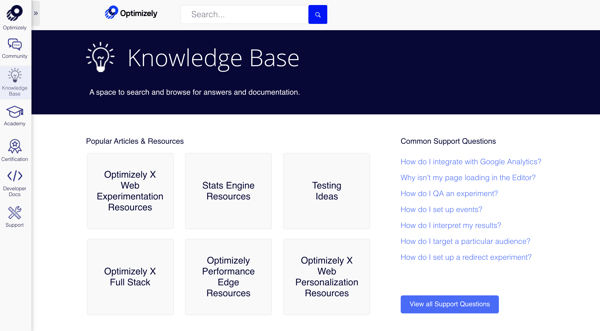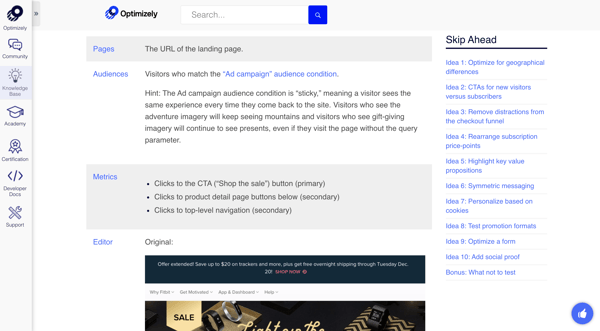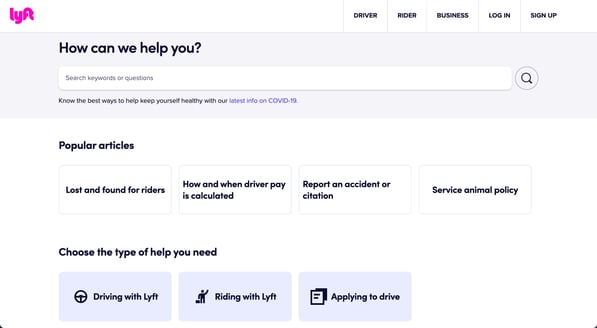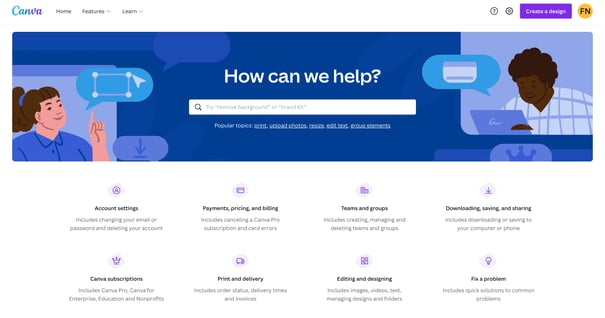Creating & Managing a Knowledge Base
More than 69% of consumers prefer to solve issues on their own, and 63% almost always start with a search through a company’s online resources before ever turning to a support rep.
→ Access Now: Free Knowledge Base Article Template
When customers would rather search their questions and get an immediate solution than pick up the phone, you need to speak to their desire, and the best way to do so is through a knowledge base.
This guide will serve as a comprehensive resource for creating and managing a knowledge base. Using the chapter links above, feel free to treat this guide like a choose-your-own adventure story and jump to specific sections to read what’s applicable to you — or peruse the whole thing.
What Is a Knowledge Base?
First off, let’s define "knowledge base."
A knowledge base is a self-serve customer service library that includes information about a product, service, or topic that helps customers find answers so they can solve problems on their own. They usually look something like this.
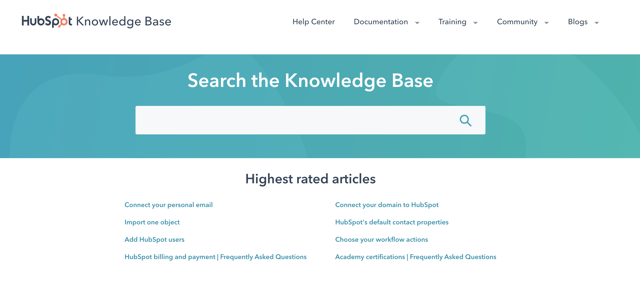
There are two main forms of knowledge bases: machine-readable and human-readable.
- Machine-readable knowledge bases store data that can only be analyzed by artificial intelligence systems. These solutions are interpreted and deducted by machines and, thus, are less interactive.
- Human-readable knowledge bases store documents and physical texts that humans can access. They are more interactive and hands-on but require time-consuming prompting to gain solutions.
What type of data is included in a knowledge base?
All knowledge bases share valuable information with customers and prospects, but the type of data and information you include in it depends on your business’ purpose for creating one. Common types of data included in a knowledge base are:
-
Directions and tips for using your products and services,
-
Answers to FAQs,
-
Content you’ve created that can provide in-depth solutions,
-
Video demonstrations,
-
Company information,
-
Knowledge on different business departments.
Some businesses also create content that is helpful for general consumers in the industry, not just specific customers. This provides useful information and exposes your content to different audience groups that may become customers if they benefit from the information you provide.
You can also create an internal knowledge base, where you provide helpful information to your employees, like benefits information, company holidays, etc. Knowledge bases may seem simple, but let's step back and put the idea in context.
Why You Need a Knowledge Base
Customer service departments exist to improve the customer experience. When users have a question or issue, they speak to your customer service team to get the answers they need.
This type of customer service is reactive and can become time-consuming because you have to have well-trained support staff operating these systems and interacting with customers to ensure a good experience. For example, if you work at a photo-sharing startup, you might get the same question about how to upload a photo dozens of times a day.
This reactive repetition is time-consuming, stressful, and isn’t scalable. Enter the knowledge base. Let’s go over some key reasons why knowledge bases are important.
1. It's helpful for your reps.
Whether answering questions over the phone, email, or live chat, your support teams can only handle so much at a time.
By providing a helpful knowledge base, your customers can get the answers they need on their own. This frees up your support reps to handle more important issues and allows your customers to feel accomplished that they found a solution all by themselves. After all, consumers expect your business to help them find their own solutions with self-service tools.
2. It's faster for your customers.
People no longer have the patience to flip through dusty encyclopedias in public libraries. They want answers, and they want them now. If a customer or prospect has a specific question about your company -- whether it be "What is artificial intelligence?" or "How do I apply for a job?" -- they'll assume they can simply search that question or similar keywords on your website and find the answers they’re looking for.
3. It can include all types of helpful content.
A knowledge base doesn’t simply have to be a reservoir of help center articles. It can also include functions like a frequently-asked questions (FAQ) section, a user forum, articles, white papers, how-to articles, video tutorials, case studies, and dictionaries or glossaries — anything that helps customers understand and use your products or services.
But you could also set up an IT or internal company knowledge base to help your employers learn how your organization operates, discover benefits and HR information, or get answers to common technical questions.
3. It's easy to build.
If you can't provide immediate answers to your customers, they will turn to a competitor who can. It can be tough to create and manage a knowledge base. However, it can start off easily -- think about the questions you've had customers ask you in the past and, maybe, the questions you've searched for yourself. You can analyze common tickets to determine which issues crop up most frequently that you need to address first. Slowly, your team can build an informative knowledge base that can be a constant resource. Let’s discuss how.
How to Create a Knowledge Base
Building a knowledge base brings user experience, design, architecture, and even SEO together to ensure your customers can find answers to their questions.
It also involves creating documentation that customers can understand and use to solve their problems or answer their questions.
Let's talk about some best practices for building a knowledge base and creating the content.
1. Start with the design and structure.
Let’s start with the design and structure; your knowledge base article format. Most of these start out at a high level, almost like a traditional home page for support-based content. This example from Evernote displays that.

Evernote, for example, allows you to search for a specific issue, navigate by categories (“Getting Started,” “Tips & Tutorials,” “Troubleshooting”), or search by top articles. You can also check out their other support options like tickets, social media, and its online community.
Discoverability is critical when it comes to knowledge bases. Key focus areas should be in sifting the most popular articles to the home page, making them prominent, and improving search functions so users can find their specific problems.
Without diving too deeply into information architecture or user experience design, I want to cover briefly what a good experience might look like with regards to your knowledge base. Here’s a summary of Evernote’s UX:
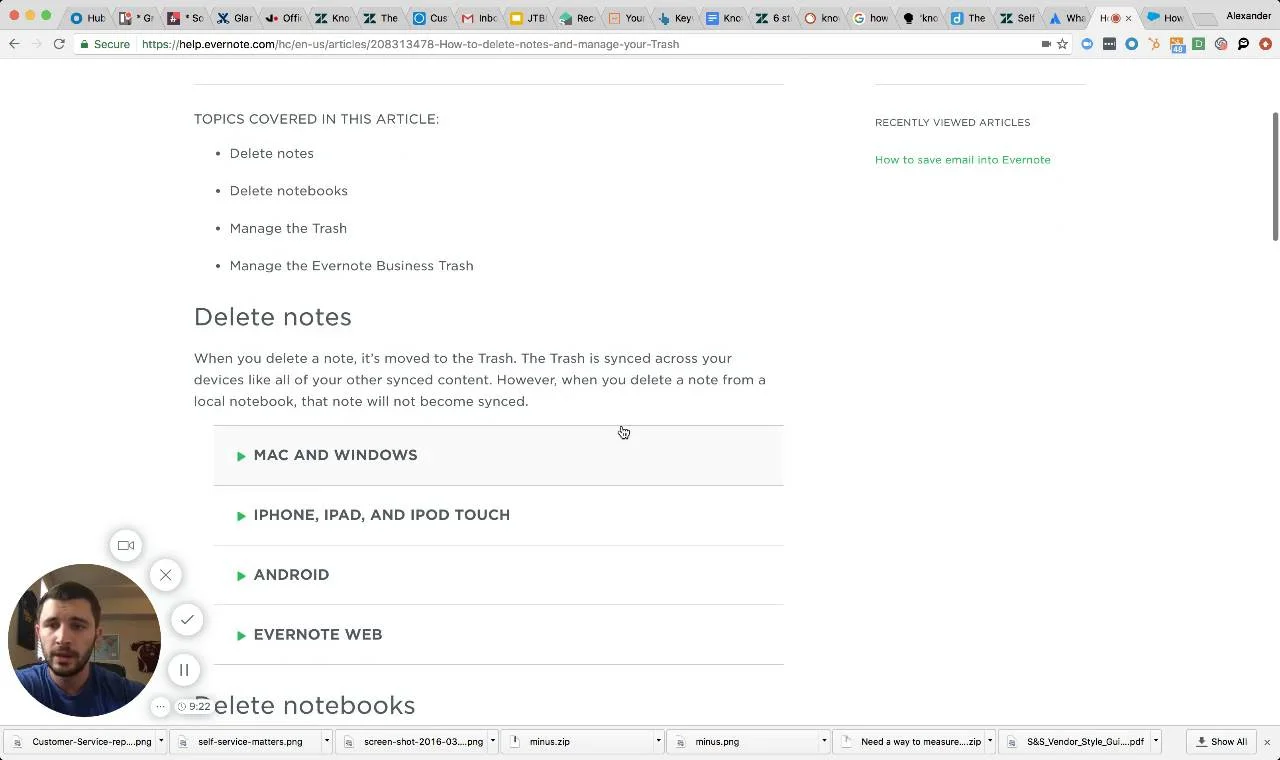
2. Determine your writing process.
Writing knowledge base articles is not unlike writing educational blog content. In both cases, you want to attract readers with a strong and clear headline, give lucid and helpful instructions, and allow them to walk away with new information or ideas.
Therefore, we can come up with a few general guidelines for writing knowledge base articles:
- Write a descriptive title.
- Be descriptive in your content, so users get all of the information they need.
- Avoid typos.
- Link to helpful resources.
- Don’t forget user experience and readability (as mentioned above).
- Add most frequently-asked questions in your support ticket auto-responder or chatbot.
Essentially, the writing principles that apply to blogs and other nonfiction instructional formats apply to your knowledge base.
But wait, that’s only for text-based articles. What about video content?
While there is a debate around which is more effective — text or video-based support content — it’s generally best to combine both. People learn differently; some prefer to read, while others prefer to watch.
Here's how Craig Stoss, Technical Support Manager at Vidyard, explains the benefits of using video content in your knowledge base:
Craig Stoss, Vidyard, Technical Support Manager
"A video enabled knowledge base allows you to reach a wider audience while reducing confusion of complex steps. Video allows you to bridge language barriers, knowledge/skill level barriers, as well as some accessibility barriers.
By describing visually, and verbally the actions you wish your users to take, you enable a wider set of your users to be successful. Difficult steps can be shown in place of complicated diagrams, or large lists of written steps. Text translations can be expensive, and can lose specific meaning in translation (especially with proprietary terms or deeply technical or industry specific terms). Text also assumes your user reads and understands at the level of the author, which can lead to confusion and frustration. Video removes these barriers by showing and not telling.Research has shown that searches related to “how-to” on YouTube are growing 70% year over year.
Customers' want to self serve and video is an increasing method to do so. Videos within articles should average between 60-90 seconds long."
As mentioned, it's best to use a combination of both. Text-based content is more likely to rank on search engines, making it more discoverable to customers searching for solutions. Video content generally allows for more visual tutorials and step-by-step walkthroughs — although video content can rank on YouTube, which is the second-largest search engine after Google itself.
3. Always include helpful visuals.
It’s always a best practice to include visuals in your knowledge base content as it can actually show readers what you’re writing about. For example, a step-by-step tutorial with corresponding images can help users visualize what they need to do. Usually, simple screenshots with annotation will suffice.
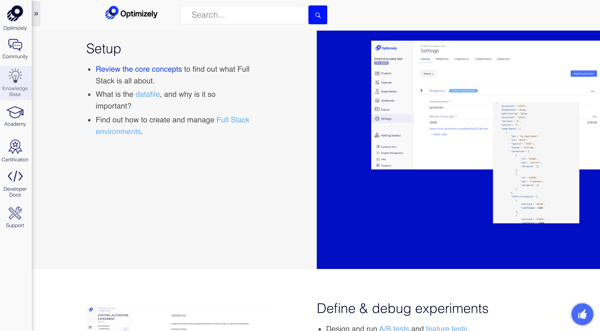
Here are a few more tips on making video content work for your knowledge management from Craig Stoss:
"They should be consistent in their tone, not display private information, and always end with a call to action that guides the viewer on what to do should the video not be helpful.
These videos will increase your customers' ability to self serve, improving customer satisfaction and reducing your caseload all while reaching a wider customer base in the medium they want to use."
Vidyard put together a great article on how you can better utilize video in your customer education if you'd like to read further.
So, you know how to create a knowledge base. Do you know what topics to include in your knowledge base? We dive into that next.
How to Choose Knowledge Base Topics
How do you know what topics to choose for your knowledge base? It’s simple: Look for trends.
When you’re getting the same question repeatedly, it’s probably time to write a knowledge base article about it. You can also find bottlenecks in the user experience of your website using tools like HotJar or Usabilla, or even simply by running some user tests to see where people struggle to complete tasks.
You can also find inspiration for knowledge base articles in your Google Analytics setup. All you need to do is check out your internal site search analytics (make sure it’s enabled). Just go to Behavior > Site Search > Overview to see the common terms people are searching for. (Tip: You can compare time periods and sort by “absolute change” to see rising trends over time.)
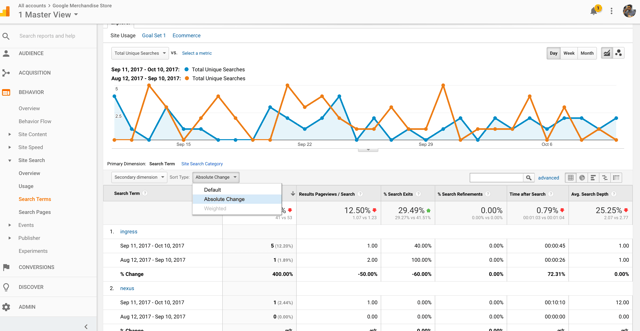
Sample view of Google Analytics from my own site
Here's how Lizzie Burns, Content Strategy Manager at SurveyMonkey's Help Center, finds trends for knowledge base content creation:
"Listening to customers is core to who we are as a company. We analyze article traffic, contact rates, and search queries from our help center, then compare it to customer support email data to uncover recurring themes and surface language patterns to create targeted content that resonates with customers.
We specifically focus on data from support emails that present self-service opportunities—common themes that can be answered in only 1 or 2 replies from our customer support team. If a question can be answered efficiently over email, it can likely be solved by self-service content, which means we can make a measurable impact with content improvements in our help center."
Now that we’ve covered how to choose your knowledge base topics, let's talk about how to manage your knowledge base.
Knowledge Base Management & Best Practices
Developing your knowledge base is only half the battle. A remarkable knowledge base is a living document that needs to be actively managed and updated to best serve your customers. These few best practices will allow your knowledge base to make the biggest impact on your customers and provide help and answers when they need it.
1. Know your audience.
Your marketing team isn't the only team that can benefit from your buyer personas. Reference your customer information when developing your knowledge base. Just as you researched trends to establish your knowledge base topics, use these trends to understand how to write about and position your knowledge base articles.
You should put as much forethought into your knowledge base articles as your blog posts and sales copy. Craft the tone and style to speak to your audience, keep them interested, and answer their questions. If they can't understand the answers you're providing, they'll get in touch with your customer service team — which defeats the purpose of proactively providing a knowledge base in the first place.
2. Keep your knowledge base on brand.
Your knowledge base is yet another reflection of your branding. Failing to keep your knowledge base consistent with your brand voice, colors, and design provides a disjointed experience for customers seeking to learn more about your products or services.
Try this: Create a style guide for your knowledge base. Keep it consistent with your overall company branding, and include formatting and writing guidelines specific to your knowledge base articles. This helps keep your knowledge base uniform and professional, no matter who's writing articles or updating content.
3. Consider accessibility.
Your website isn't the only digital space that should follow accessibility standards — your knowledge base should, too. Add alt text for all screenshots, images, and videos included in articles. Check for any contrasting colors that may be tough to see against certain backgrounds or buttons.
Also, use large, clear fonts for headers and bullet points to break up lists. Add hyperlinked tables of contents to help readers navigate long articles. Lastly, confirm your knowledge base is mobile-friendly before launch.
4. Update your knowledge base with every product update or launch.
If your products, services, branding, or company changes in any way, so should your knowledge base. If you neglect your knowledge base content, over time, it'll be useless — and customers will notice. Just as you train your customer support staff on product or service updates, so should you actively update your knowledge base articles. The same goes for creating new articles for new features or entirely new products.
Here's a tip: Only explain major concepts or features once, and simply hyperlink to that article when developing new ones that reference that concept. This helps you avoid having to update content in multiple places.
5. Share your knowledge base everywhere.
A great knowledge base isn't only accessed when needed; it's also used to support marketing content, explain sales presentations, and convert leads. While it's primary purpose is to answer questions and provide support to curious customers, it can hold value elsewhere.
For example, if you're writing a blog post and reference the relevant feature of your software tool, consider linking to a knowledge base article explaining this feature versus the product page. Not only does it provide a more in-depth explanation of the feature, but it also showcases your product in action for those readers who may not (yet) be customers.
6. Measure its effectiveness.
It’s hard to measure the effectiveness of a knowledge base. How do you know if customers are leaving your knowledge base article happily with new knowledge and answers in their head — or if they’re leaving, frustrated and without answers, contemplating changing to a competitor? On the same note, how do you know you’re creating the right content and actually answering everything your customers care about?
There are a few ways to measure how well your knowledge base is working. First, include basic, one-question feedback surveys at the end of each article. These surveys don't have to be complicated — you could simply ask "Was this article helpful?" and have customers click a thumbs-up or thumbs-down based on whether they found their answers. Secondly, provide an email address or phone number for customers to provide further feedback or ask additional questions.
You'll only know if your knowledge base is working if you ask the people who you're creating it for — your customers.
Now that we’ve covered some best practices and how to write great knowledge base articles, let’s look at some examples of companies that do it well.
Knowledge Base Templates & Examples
You’ve got a good grasp of the theory and best practice, but what does an effective knowledge base look like? For that, let’s go over some excellent knowledge base examples.
→ Access Now: Free Knowledge Base Article Template
1. Optimizely
Optimizely’s knowledge base is huge, and it contains a community forum, a traditional knowledge base, an educational academy, certification programs, developer documentation, and a link to regular support.
Here in this image, you notice that three elements are prominent: left-hand navigation, search functionality, and popular articles/common questions. This is just the tip of the iceberg (and it’s a great way to get people started without overwhelming them). When you scroll further, you see the crazy breadth of topics they cover here.
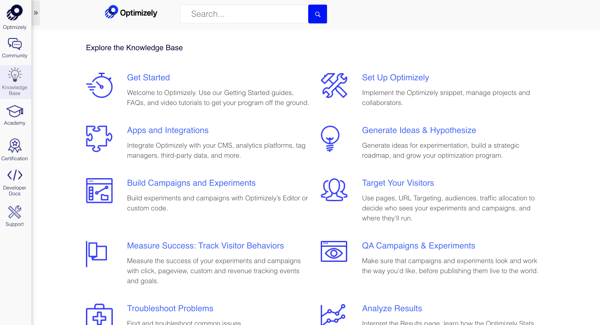
When you click on an individual article, like the following tutorial on personalization targeting, you’ll be pleasantly surprised at the depth and descriptiveness of the content. It’s really easy to walk away from these articles knowing what actions you need to take to get things to work in the product. Good mix of images, video, and text as well.
You can also see that they frequently link out to other helpful sources within the body content as well as on the sidebar. This helps users find solutions to related issues.
Here’s how Adam Avramescu, Director of Customer Education at Optimizely, talks about their knowledge base:
Adam Avramescu, Director of Customer Education, Optimizely
”As an experimentation company, we took a data-driven, iterative approach to our knowledge base. Through experimentation, we questioned common assumptions about how knowledge programs should work and explored search-first vs. browse-first behaviors; article lengths; recommendation algorithms; and more. What we have today is a knowledge base that not only helps customers answer support questions easily, but also serves as a competitive differentiator in the market. When you have a question about Optimizely or optimization, even if you're coming in through organic search, the knowledge base is often the first stop.This builds our customers' and prospects' trust, and shows that we're experts in the field of experimentation."
2. SurveyMonkey
When it comes to a knowledge base design template, SurveyMonkey has one of the best examples I’ve seen. It’s clean, beautiful, simple, and intuitive. I like the visually prominent search bar and the clear topic categories.
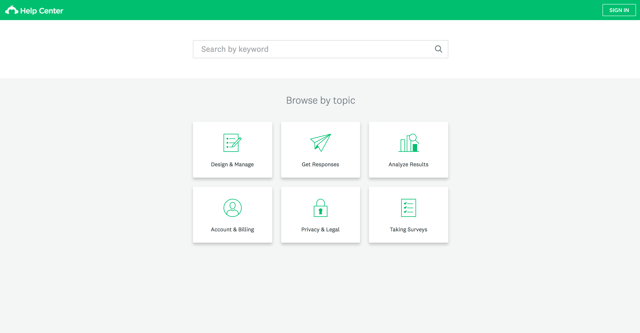
As a large percentage of your users will use the search feature to find their specific question, I tested out the functionality here, and it brings up super-relevant search results (but also keeps the categories prominent in case you’d rather browse). In addition, you can see a visually prominent sidebar module to sign up to get faster service, as well as a less prominent module to contact them for support (as a last resort, presumably).
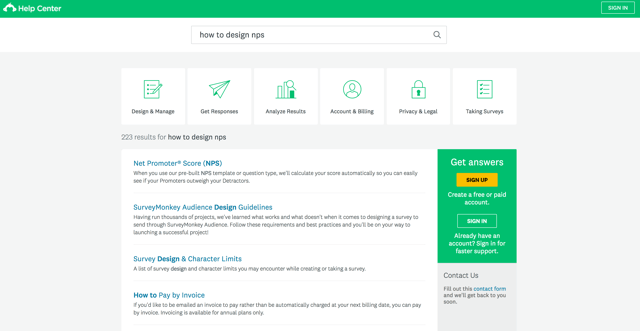
When searching, it also helps to have a good autocomplete system to suggest possible questions your user may have. SurveyMonkey has this feature, and I can only assume the suggestions are ordered by popularity or some sort of context (or they should be, at least).
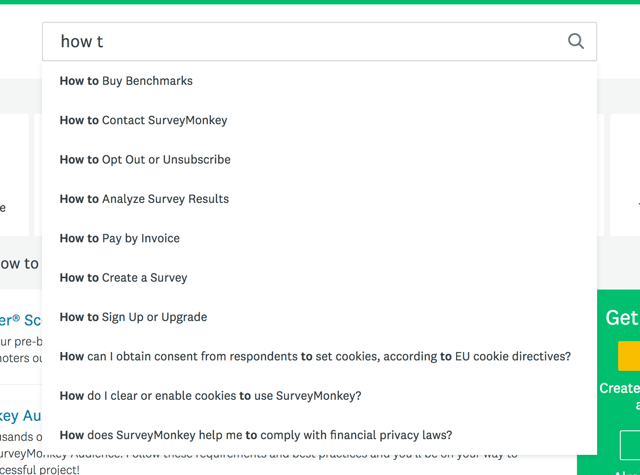
Finally, when you do click into a knowledge base article, the design is still great, and you get the information you need. More notably, look at the highlighted topic category and navigation breadcrumbs — you know exactly where you are on the site. (It can be stressful to get lost on a website, especially when you’re searching for answers).
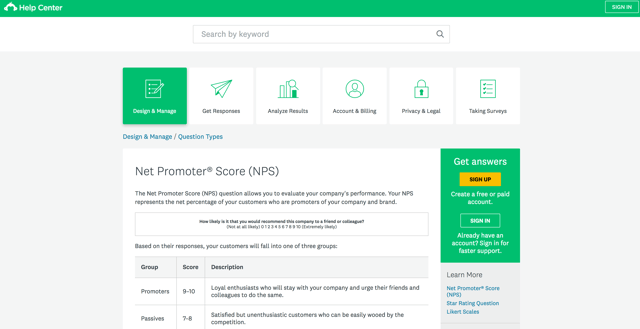
Within the article, SurveyMonkey also links to product features like survey templates. This can be helpful to get the user started as well as to simply get them to use the product.

The only thing I can think that they could add is some sort of feedback mechanism to see whether or not an individual article is actually helpful (or how it may be improved). In the absence of a feedback-related action, optimizing a knowledge base for usefulness is hard.
3. Microsoft
The next knowledge base example we have here does a great job of capturing and utilizing feedback.
I’ve spent a ton of time on the knowledge base for Microsoft Excel (as I’m sure many other people have). It’s generally a really good example of how to build a knowledge base.
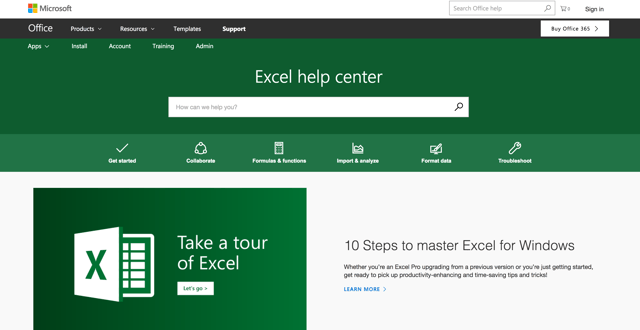
The cool thing is that Microsoft has clearly done its research and analysis and has built the knowledge base homepage to reflect top user concerns.

They also offer trainings and higher-level education on Microsoft Excel.
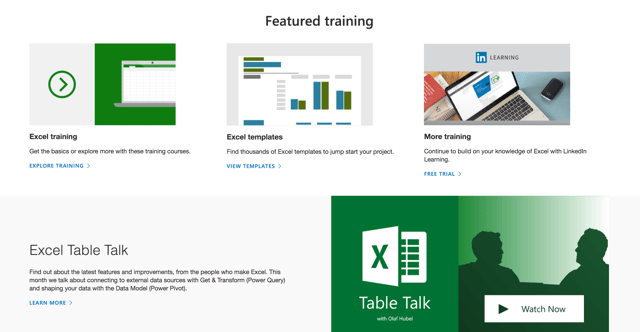
The actual knowledge base article itself is readable, scannable, and helpful. You can jump to specific sections, and they also link out to related content frequently in case you're not in the exact right place.
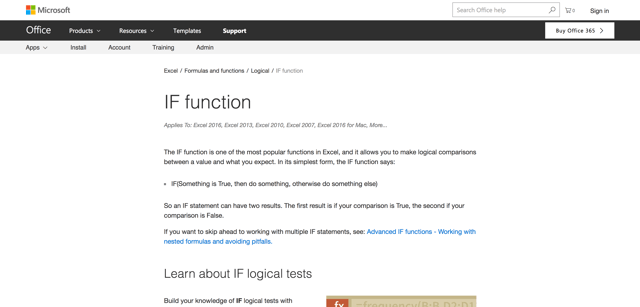
Finally, they give you the chance to rate the quality of the article on a binary scale. This helps them measure effectiveness and optimize knowledge base articles as needed.

4. HubSpot
We focus a lot on customer education here at HubSpot.
HubSpot's Help Center provides free tools and training to help businesses and individuals grow. It has a Knowledge Base section that provides tons of knowledge to readers in the form of user guides, quick answer documents, HubSpot user groups, and community discussions.

The HubSpot Help Center also links to HubSpot Academy, where users can find answers to their questions, grow their skills in the areas they’re interested in through videos and classroom training, and get certified in certain topic areas.
According to Lauren Pacifico, a technical writer at HubSpot who works on the knowledge base ...
“Self-service resources are a critical part of reducing customer friction and deflecting cases from your customer support team.
As creators of those resources, the goal for us is to provide clear, concise information to our customers so that they can find the answers they need quickly and get back to getting things done.”
5. Lyft
Lyft goes above and beyond by providing a knowledge base for both drivers and riders. Rather than just structuring it as a search bar that comes up with keyword-based solutions, Lyft has pre-written brief blog posts that provide valuable advice to both groups, such as "How to change navigation settings,” for drivers, and “Using Google TalkBack to request a ride.” for riders.
Information in the articles is condensed into a few, short paragraphs, making it easy for riders to quickly find the information they need, like how to contact a driver about a missing item, and for busy drivers to save time finding information on the go.
By separating its knowledge base by user demographics, it makes the information all the more accessible and relevant.
6. Canva
Canva’s support page has an aesthetically pleasing, clean-cut layout that makes finding the appropriate tools simple and quick. The landing page features articles based on FAQs, but the best part is that clicking on one overall parent category, say payments, pricing, and billing, leads to additional child categories that help you find a resource as specific to your issue as possible.
The knowledge base also features a search bar where visitors can enter keywords related to their issues and find a solution. Even when conducting their search, the knowledge base makes sure to surface the most relevant and top clicked result first (as shown below), helping users come to quick solutions.
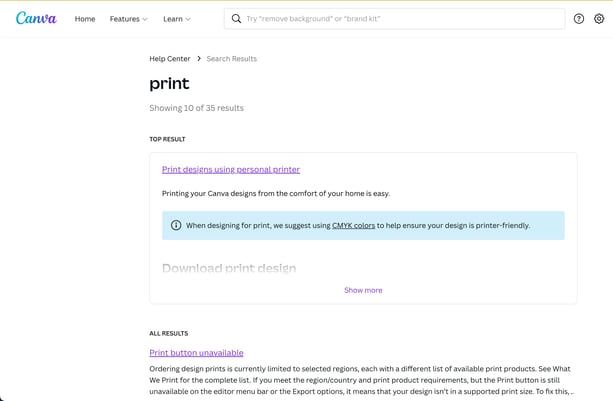
7. Moz
Moz is a stellar example of using knowledge base content not simply for reactive customer support, but for proactive customer education as well. They even refer to their knowledge base as a "learning center," which shows you how they're framing their efforts.
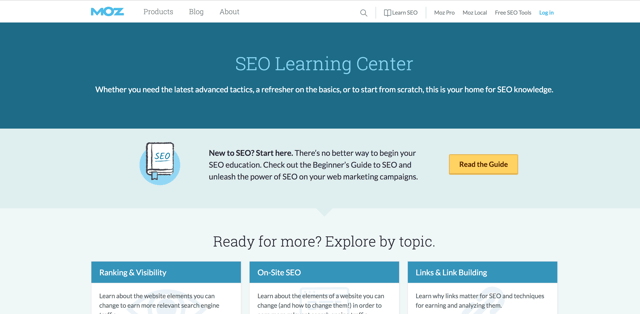
You'll notice from the prominent CTA on the home page that they're promoting a guide to SEO. This is different than most knowledge bases, in that it's not explicitly product focused. It's not about what Domain Authority means or how to find it in the tool. It's about SEO more generally and how to excel at the dark art. The rest of the learning center continues on this way, with lessons in many different facets of SEO.
Finally, you get to a point where you can get product specific content.
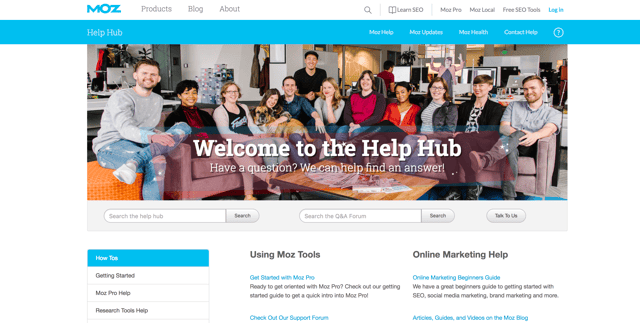
This breaks down further into different knowledge base sections, such as support community, their outstanding blog, and a video-based academy. Here's an example lesson from their academy:
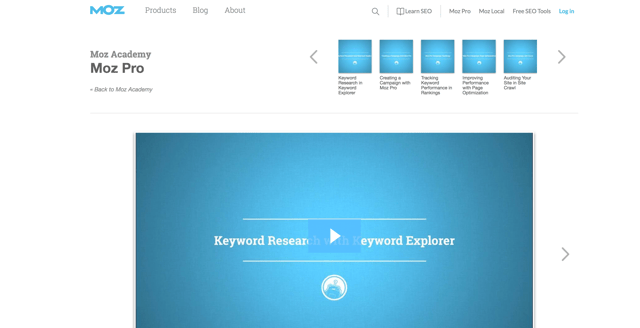
Any given product-based help article is high quality, and it includes a variety of teaching styles — step-by-step text, images, video. They're comprehensive and it's hard to imagine walking away without finding your answer.
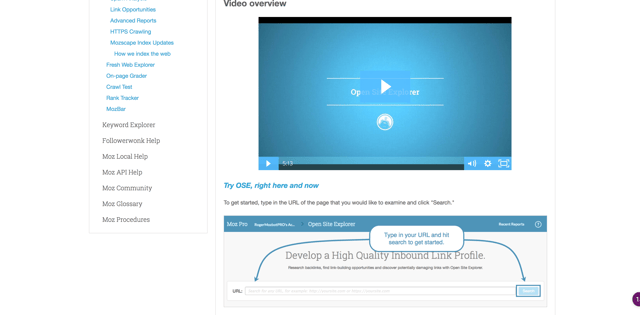
Now, we’ve gone through what makes a good knowledge base article, and we’ve also seen a few good examples and templates. Even though, technically, you should do the research on your own to consider what topics you should write about, it’s helpful to have a sort of FAQ template, or at least something to get you thinking about what types of articles to write. So here are a few ideas:
- When does my order ship?
- How long will it take to get my order?
- How can I cancel my subscription?
- How do I enter a promo code?
- When do you charge my card?
- How long does my trial last?
- How can I get in contact with support?
Same deal with knowledge base articles: if you’re getting the same question over and over, write up an FAQ page for it.
Generally speaking, you want to cover real objections and questions customers may have (not ones imagined by your branding or SEO team). You don’t have to be running a complicated software product for this to be beneficial. Ecommerce companies need to worry about customer success and retention, too. Death Wish Coffee does this well:
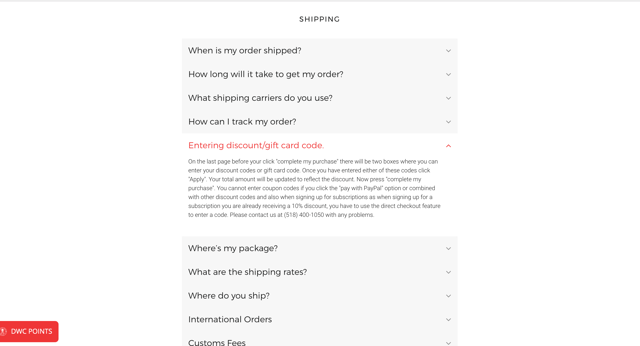
Knowledge Base Tools & Software
As companies have increasingly started valuing the idea of creating a knowledge base, it’s been easier and easier to build one — at least from a technological standpoint.
As a result, there is now a variety of knowledge base tools and software for companies of any size or stature. Options range from knowledge base software and FAQ software all the way to enterprise solutions.
To start lean, let’s cover knowledge base software.
First, if you can rig up your CMS software to serve the purpose of a knowledge base, that may work alright for you. So whether you use HubSpot or another system to manage your website content, it’s quite likely you could also use this to set up your customer education content.
If you’re using WordPress, it’s easy enough to find free knowledge base solutions as plugins - one of the most popular options is the WP Knowledge Base plugin. With this, you simply need to install the plugin, add categories, add articles, and choose a page where your knowledge base will be accessible. Further instructions for building a knowledge base on WordPress can be found here.
Of course, if you’re in search of scalability and flexibility, you may have to use a specific knowledge base solution. While there are many out on the market, you simply have to choose base on the business criteria you’ve chosen. Some questions that may help you choose could be:
- Is this knowledge base software free? What does it cost?
- Do we need forum or community features? Is this the best forum software for us?
- Does this software give us the analytics we need?
- How is the support for this software?
- Does the software integrate well with other tools we’re using?
In short, it’s like any other decision where you must weigh the pros and cons and find what works best for you. You might want to check out software review sites like G2 Crowd, Capterra or Software Advice. Or simply get on a call with companies you’re interested in to see if they can offer the features and support you’re looking for.
Conclusion
Building a knowledge base can help you scale out your customer support and customer success efforts — without having to add new customer support staff. As such, it can help you reduce costs, improve customer satisfaction, and boost the ROI of your customer success organization.
In addition, it can help you to focus more on proactive efforts such as customer education and empowerment instead of simply reacting to support tickets. This shift can be a huge organizational win.
There are many ways to build an effective knowledge base, but it all boils down to answering important and frequent issues that come up with customers.
Created By
Get early access to knowledge base software
HubSpot is releasing knowledge base software in 2018. Get notified when it's ready for action.


